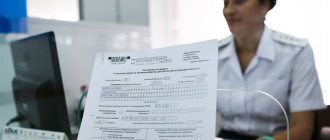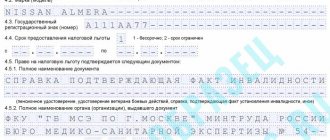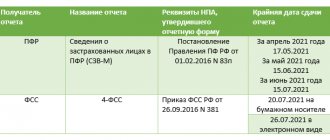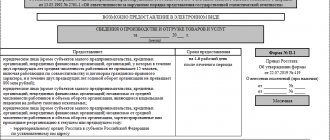Who is required to submit a declaration
In 2020 and earlier, the document was filled out by organizations - owners of vehicles, which must transfer this fee in accordance with Chapter 28 of the Tax Code of the Russian Federation and the laws of the constituent entities of the Federation.
IMPORTANT!
The transport tax return for 2022 for legal entities is not submitted. From January 1, 2022, the transport report to the Federal Tax Service is canceled (Clause 9, Article 3 63-FZ of April 15, 2019). This means that taxpayers do not submit a return for 2020. If the company is reorganized in 2020, the inspector will only accept the updated form submitted during 2022.
According to the rules in force in 2022, a tax return for transport tax is submitted to the tax authority at the location of vehicles (in accordance with paragraph 1 of Article 363.1 of the Tax Code of the Russian Federation) or at the place of registration of the largest taxpayer (in accordance with paragraph 4 of the same article ).
The fee is regional, so rates vary in Russian cities.
In what cases is it not necessary to pay transport tax?
There is no need to pay transport tax if the vehicle is registered and deregistered:
- in the period from the 1st to the 15th of the month;
- from the 16th to the 30th of the month;
- when registering after the 15th of one month and deregistering before the 15th of the next month;
- one day.
Such clarifications are given in the letter of the Federal Tax Service of the Russian Federation dated June 19, 2017 No. BS-4-21/ [email protected]
In addition, no tax is paid in case of car theft (letter of the Ministry of Finance of the Russian Federation dated October 3, 2017 No. 03-05-06-04/64192).
The agency explained which documents can exempt the owner of a car from paying transport tax if it is stolen.
According to paragraphs. 7 paragraph 2 art. 358 of the Tax Code of the Russian Federation, a vehicle will not be taxed provided that supporting documents from law enforcement agencies are provided to the Federal Tax Service. They may be:
- certificate of theft;
- resolution to initiate a criminal case.
In addition, the department reminded that a lost car can be deregistered with the State Traffic Safety Inspectorate (Order of the Ministry of Internal Affairs of the Russian Federation dated November 24, 2008 No. 1001). To do this, the owner will need to send an application to the appropriate traffic police department.
Let us note that Art. 85 of the Tax Code of the Russian Federation obliges the traffic police to independently, without the participation of the owner of the vehicle, report to the Federal Tax Service the fact of deregistration of a stolen car. This is done within 10 days. If a stolen car is found, it can be registered again.
Deadline
Previously, the deadline for submitting a transport tax return was no later than February 1 of the following year. If it coincided with a weekend, the deadline was postponed to the first subsequent working day. But in 2021, the form is canceled: reporting in February for 2022 is not required.
Important changes for 2022
The 2022 transport return is the last report that taxpayers will have to submit. In 2022, the transport tax return for 2022 for individuals conducting business activities and legal entities is not submitted to the Federal Tax Service. Innovations are enshrined in clause 17 of Art. 1, part 3, 9 art. 3 of Federal Law No. 63-FZ of April 15, 2019.
How to apply an increasing coefficient for transport tax
The list of passenger cars with an average cost of 3 million rubles, subject to use in the next tax period, is posted no later than March 1 of the next tax period on the official website of the Ministry of Industry and Trade of the Russian Federation on the Internet. This follows from paragraph 2 of Art. 362 Tax Code of the Russian Federation. The cost of the car and the moment of its registration do not play a role.
Particular attention should be paid to the last column of the list, which indicates the age of the car, which is counted from the year of manufacture. For example, a car that was released in 2016 is 1 year old in 2016, 2 years old in 2022, etc. (letter of the Ministry of Finance of the Russian Federation dated May 18, 2017 No. 03-05-04/30334, Federal Tax Service of the Russian Federation dated March 2, 2015 No. BS-4-11 / [email protected] ).
If there is a car on the list, but its age is different, the increasing factor is not applied (letter of the Federal Tax Service of the Russian Federation dated January 11, 2017 No. BS-4-21/149).
If your car is on the list, then pay tax for 2022 with an increasing coefficient.
| Group of cars according to the list | Year of car manufacture | Kp coefficient |
| From 3 to 5 million rubles. | 2017 and later | 1,1 |
| From 5 to 10 million rubles. | 2015 and later | 2 |
| From 10 to 15 million rubles. | 2010 and later | 3 |
| Over 15 million rubles. | 2000 and later |
Filling out the declaration: step-by-step instructions
Let us use a specific example to examine the procedure for filling out a transport tax return, which was in effect until 2022 inclusive.
Vesna LLC is registered in St. Petersburg, is engaged in the wholesale trade of flour and pasta, and owns one Scania R420 truck - it has been owned for 6 years. Local law in St. Petersburg establishes advance payments for this tax. In our case, the amounts of advances do not play a role, since they are not taken into account when paying tax on trucks (see letter of the Ministry of Finance of the Russian Federation No. 03-05-05-04/3747 dated January 26, 2017).
Step 1. Title page
Filling procedure:
- at the top of the page we will indicate the company’s tax identification number and checkpoint, then they are automatically duplicated on each sheet of the declaration;
- adjustment number when submitting the declaration for the first time - 000;
- tax period code for the calendar year - 34. For the last tax period upon liquidation - 50;
- reporting year - 2019;
- The tax office to which the declaration is submitted has a unique four-digit code, find it out by contacting the Federal Tax Service or on the Federal Tax Service website: the first 2 digits are the region code, the second 2 digits are the code of the inspection itself. The declaration is submitted to the Federal Tax Service at the location of the vehicles, which the organization usually registers at its location. Or at the location of a separate subdivision - when registering vehicles (TS) with the subdivision. For example, Federal Tax Service Code No. 9 of the Central District of St. Petersburg;
- the taxpayer enters a code at the place of registration, which depends on his status. Codes - in Appendix No. 3 to the filling procedure:
| 213 | At the place of registration of the organization - the largest taxpayer |
| 216 | At the place of registration of the legal successor of the largest taxpayer |
| 260 | At the location of the vehicle |
Vesna LLC is a Russian company that is not a major taxpayer. Enter code 260. Fill in the rest like this:
- We enter the title in the longest field of the title page, skipping one cell between the words;
- We check OKVED using the classifier. Vesna LLC sells wholesale flour and pasta: OKVED code 46.38.23;
- phone number;
- number of pages in the declaration. Vesna LLC submits a declaration for this tax for 2022 on three sheets;
- We will write your full name at the bottom of the title page. taxpayer (director) or his representative, we will put the filing date and signature.
Step 2. Section 2 for each vehicle separately
Line by line:
- 020 - OKTMO code in the territory of which the car is registered. Find the code on the Federal Tax Service website;
- 030 - code of the type of vehicle, which are listed in Appendix No. 5 to the procedure for filling out the declaration. In the example for Vesna LLC, 520 01 is indicated for a truck. The table shows the most commonly used codes:
| Code | Vehicle name |
| Aircraft | |
| Aircraft | |
| 411 12 | passenger airplanes |
| 411 13 | cargo planes |
| Helicopters | |
| 412 12 | passenger helicopters |
| 412 13 | cargo helicopters |
| Water vehicles | |
| Sea and inland navigation vessels | |
| 420 10 | passenger and cargo sea and river self-propelled vessels (except those included under code 421 00) |
| 420 13 | sea and river self-propelled cargo vessels (except those included under code 421 00) |
| 420 30 | sports, tourist and pleasure boats |
| 420 32 | self-propelled sports, tourist and pleasure craft (except those included under codes 422 00, 423 00–426 00) |
| 422 00 | yachts |
| 423 00 | boats |
| 424 00 | jet skis |
| 425 00 | motor boats |
| Ground vehicles | |
| 510 00 | passenger cars |
| 520 01 | trucks (except those included under code 570 00) |
| Tractors, combines and special vehicles | |
| 530 01 | agricultural tractors |
| 530 03 | self-propelled combines |
Next line by line:
- 040 - VIN - vehicle identification number;
- 050 - brand - indicate Scania R420;
- 060 - state registration number assigned to the car;
- 070 — the field is intended to indicate the date of registration of the vehicle according to the documents;
- 080 - line is filled in in case of deregistration. It is important to use registration documents;
- 090 - tax base for transport tax. Define it as follows: if the vehicle has an engine, then indicate the power in horsepower. In our example, this indicator is used, and the sample declaration itself indicates 420 liters. With.;
- When filling out a report for an aircraft, enter the nameplate static thrust of the jet engine (the total thrust of all engines) at takeoff in kilograms of force or the power of the vehicle engine in hp. With. Owners of non-self-propelled (towed) water vehicles indicate the gross capacity in registered tons, and owners of self-propelled vehicles indicate the engine power in hp. With.;
- if we are talking about water and air vehicles not specified in subparagraphs 1, 1.1 and 2 of paragraph 1 of Art. 359 of the Tax Code of the Russian Federation, the tax base is defined as a vehicle unit, and in line 090 they put 1;
- 170 is the tax rate determined at the level of the subject of the Federation. To determine regional rates, use the Federal Tax Service service. In St. Petersburg, the rate is for trucks with a capacity of more than 250 hp. p., from the year of issue of which more than 5 years have passed, is 85 rubles (see Article 2 of the Law of St. Petersburg No. 487-53 dated November 4, 2002, as amended on June 21, 2016);
- 180 - the increasing Kp coefficient is indicated when owning a passenger car with an average cost of 3,000,000 rubles and depends on its year of manufacture (the coefficient varies from 1.1 to 3). Such machines are included in a special list (information from the Ministry of Industry and Trade of Russia dated February 26, 2016). In other cases, put dashes;
- 190 is the amount of tax calculated for the truck. Formula for calculation:
or by lines
Line 190 = page 090 × page 170 × page 150 × page 160 × page 180.
Let's calculate the tax amount for our example:
Let's continue filling:
- 200–270 - these lines are filled in if there are tax benefits. Vesna LLC does not have benefits, so we put dashes. See the table for codes:
| Code | Name | Base |
| 20200 | Transport tax benefits established by the laws of the constituent entities of the Russian Federation, of which: | Art. 356 Tax Code of the Russian Federation |
| 20210 |
| |
| 20220 |
| |
| 20230 |
| |
| 30200 | Benefits (exemptions) for transport tax provided for by international treaties of the Russian Federation | Art. 7 Tax Code of the Russian Federation |
- 280 - field for organizations that have heavy vehicles registered in the Platon system. It contains the deduction code - 40200. If the declaration is filled out for a passenger car, dashes are added;
- 290 - here we indicate the amount that the organization deposited into the account of the Platon system operator. If for some reason you do not remember how much money you paid for damages, make a request for each vehicle through your personal account in the system. Vesna LLC paid a fee of 10,000 rubles;
- 300 - if there are no benefits or deductions, the indicator from field 190 is transferred to this line. In our case, it is necessary to calculate the final amount. These are indicators from page 190 - data from page 290. In numbers, this is 25,700 rubles.
If the organization owns a car, the declaration must be filled out in the same way, but with minor differences. Note:
- vehicle type code - passenger car - 51000;
- the number of years that have passed since the year of manufacture does not need to be filled in, since rates for passenger cars in St. Petersburg are not differentiated depending on the age of the car.
Transport tax when using the Platon system
From 01/01/2019, the benefit established by the Law of 07/03/2016 No. 249-FZ, which provides for a reduction in transport tax by the amount of payment for road damage caused by heavy trucks to federal roads, ceased to apply. Deductions were provided for tax periods 2016–2018. Now the preference has ceased to apply.
Transport tax is a regional tax. When introducing it into effect in the territory of their region, legislative (representative) bodies of a constituent entity of the Russian Federation can establish differentiated tax rates for each category of vehicles, as well as taking into account the number of years that have passed since the year of production of vehicles and (or) their environmental class. Additional tax benefits may also be provided to owners of heavy trucks.
Another change in the procedure for calculating and paying tax is related to the need for owners of heavy trucks registered in the Platon system not only to calculate, but also to pay advance payments for transport tax, if the region provides for the payment of advance payments for it. In Moscow, according to Part 1 of Art. 3 of the Law of Moscow dated July 9, 2008 No. 33, there is no such obligation. The innovation is caused by the termination of the provisions of the already mentioned Law of July 3, 2016 No. 249-FZ. It was allowed to calculate but not pay tax advances until 01/01/2019.






